In early January 1915 Salisbury witnessed exceptionally heavy rains that lasted for several weeks culminating in severe floods which surrounded Salisbury and in particular, Fisherton Street. The area between Summerlock and Fisherton Bridges was completely covered with water and this gave great cause for concern. The rise in the water level stayed and there was a steady fall, and by eight o’clock in the evening the street was fairly clear, the deepest pool being in front of the Primitive Methodist Chapel.
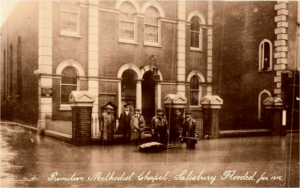
The Town Council put their employees to work. The men put boxes on the pavement and planks on top of them thus providing a footpath above the water – along this the pedestrians had to move in single file.
Soon Fisherton Street was clear of the water, but in Chapel Place the downstairs rooms of the houses were still covered to a considerable depth, and women and children were unable to quit the upper floors.
Then a worse state of affairs arose. The water in the River Avon commenced to rise again and the Nadder followed suit. The drains in Fisherton Street began to overflow through the gratings, and under the South Western railway arch a pool spread rapidly till it became a good-sized pond, in height within an inch of the raised path on the east side of the road. Very soon Fisherton Street was inundated far beyond the depths previously reached.
Houses on both sides were flooded. As the water continued to rise, it became almost impossible for vehicles to get through the flooded area under the railway arch. One well-known tradesman came up-stream in a punt and waited on the ‘shore’ at the railway arch end while a messenger was dispatched to an office near the station for letters that had been left to be called for. A novel way of passing down Fisherton Street without getting wet was to ride piggyback if a policeman would let you! Our photograph shows one genial member of the force carrying a passenger that way and he is rewarded by being captured on film for evermore!
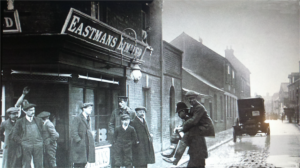
The flooding extended to the Cathedral Close, and gradually oozed through the grass of the green lawns and made a big lake there, practically covering the expanse before the Western end, and extending round to the north side, where it ran up to the walls of the Cathedral and overflowed into the entrance porch and into the nave.
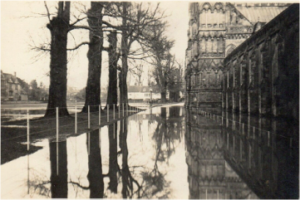
The damage and loss suffered by traders was enormous. Most of the residence in Fisherton Street passed the greatest part of the time upstairs, and were glad of the services of passers-by whether in boats or wheeled vehicles to deliver messages to the outside world. Among the passengers was the Mayor (Clr. J. Macklin), who was punted up and down by a couple of constables and assisted in distributing provisions. Parcels were delivered by being hauled up to the bedroom windows by a rope. It may interest Fisherton History Society members to know that in the Gaol Ground district of Fisherton, many houses were submerged.
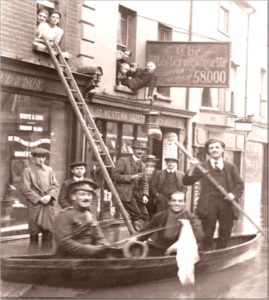
Eventually the paths in Fisherton were passable, though there was still much water in the road. The Salisbury Cathedral was also quite dry. The local newspapers offered their congratulations to the City surveyor and his staff, and the Chief Constable and his staff who: “have done all they could in a very difficult and disagreeable crisis, and the Fire Brigade also played an important part at critical stages.”
It is worth noting that Fisherton was also the subject of a terrible flood in 1852 as noted by the Illustrated London News of December 11th 1952. “The city of Salisbury has been visited with serious floods. All the lower parts of Fisherton have been from two to three feet under water. The inhabitants of several of the cottages were compelled to betake themselves, with their furniture, to the upper floors; and, in many cases, considerable suffering and distress have been the result. Of course the foot passenger traffic was suspended, and horses and carts plied for hire between the Infirmary and the turnpike. The ordinary shallow stream that transverses Back Lane (now Waters Lane), became a roaring flood; and the Avon extended its swollen waters right and left, so as to threaten the stability of the town-mill, and the adjacent premises. In Back Lane two cows, which had strayed into the water, were carried down by the flood, but were saved from drowning by the coming into contact with Summerlock-bridge, the arch of which being covered with water, stopped the cows, and thus enabled them to be rescued. A correspondent of the Salisbury and Winchester Journal states that Dr. Finch and Mr. Jackson were in heavy rain and knee high in water on the North side of Fisherton Street, distributing 1s per head to the poor families. Also, two men, in the employ of Mr. James Blake, landlord of the Waggon and Horses, Fisherton, went from door to door distributing a quart of strong beer to each family. Both acts of kindness were gratefully received; and the assistance in money enabled the poor to provide themselves for pressing necessity.
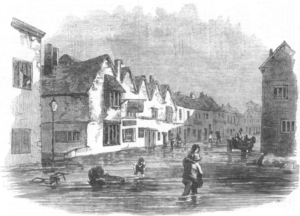
The Fisherton floods of 1852. Note the Summerlock Bridge and the Waggon and Horses on the left hand side.
Fisherton has, however, experienced a longer visitation of flood than that we have just described; for, in the winter of 1809, the water ran through many of the houses there for nearly six weeks.
Indeed, the winter of 1809 was extremely bad. From the middle of January in that year, a deep snow rapidly melted, and the rivers overflowed their banks. From that time, to the end of February, there was continual rain – not a single fine day intervening. For nearly six weeks service was not performed in the Cathedral. This dreadful winter was followed by a wet harvest. During the first week in August, there was a tremendous thunderstorm which was succeeded by heavy rains till the beginning of October, by which the corn was most seriously damaged.
Again in February 1883 Salisbury witnessed serious flooding and the people of Fisherton had to dam up their premises against the invasion of water, which caused considerable damage – one tradesman estimating his loss at £300. The two principal hotels in Fisherton were dammed up. The River Avon again overflowed its banks and submerged the thoroughfare with extensive flooding in Fisherton Street.

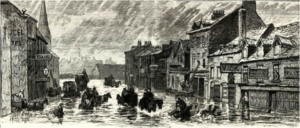
Fisherton in the 1883 floods
The floods returned with a vengeance in 1894 when it was stated that the water above the town bridge and Summerlock Bridge in Fisherton was higher than at the time of the memorable flood in 1883, when most of that part of the city was inundated to a depth around three feet. It was rumored that Longbridge in Mill Road had been carried away but this proved to be incorrect – although the greater part of the bridge was under water. During the day, by order of the Mayor, planks were placed along Fisherton roadway to the entrance of the cottages, and in the evening his Worship sent two loaves of bread and a quantity of tea to each household.
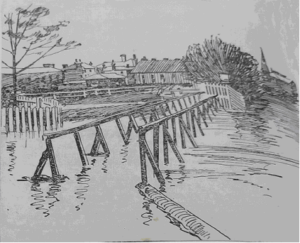
The scene at Longbridge, Salisbury – November 17, 1894
To the Editor of the Salisbury and Winchester Journal
THE FLOODS IN SALISBURY
Dear Sir, I have gratefully to acknowledge numerous offers of help, as well as some gifts, on behalf of those whose homes have been visited by the recent floods. Amongst the gifts received is a very liberal one of £20 from Mr. and Mrs. Hulse. Such sums have enabled the Flood Committee of the Town Council to inquire into and relieve all pressing cases.
Were it necessary to appeal to the generous help of my fellow citizens I am quite sure there would be a ready response, but I am glad to say that the funds in hand are being given in kind rather than in money, and will be continued as long as considered needful.
Though we are thankful that the damage has not been more serious, yet we must sympathise very sincerely with those who have experienced so much inconvenience and discomfort from the inundation.
Yours faithfully, Edward F. Pye-Smith. Mayor
The Close, Salisbury, 22nd November, 1894